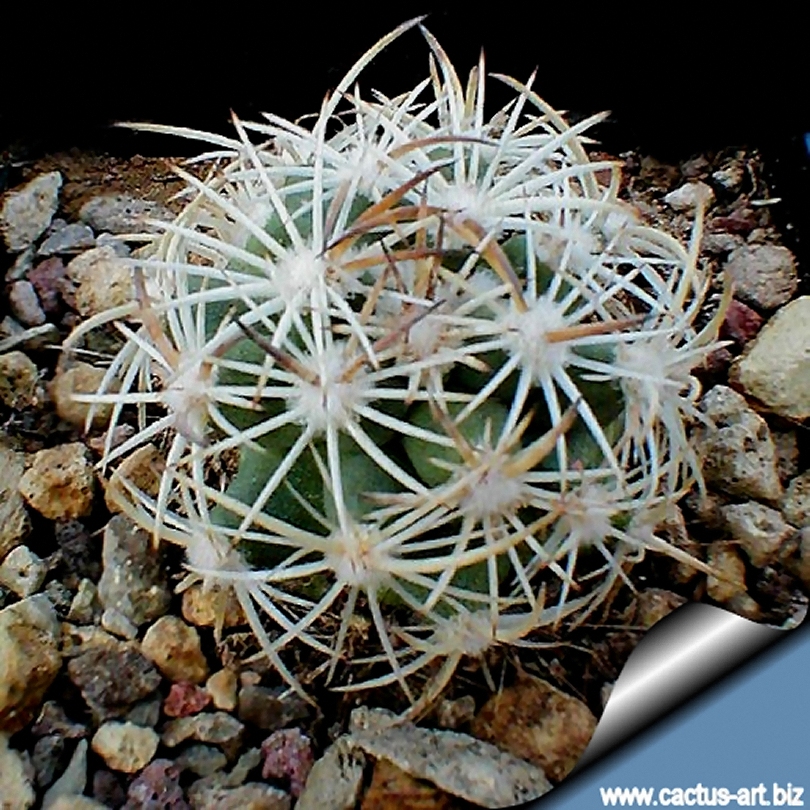|
|
Pediocactus sileri
(Syn: Sclerocactus sileri, Utahia sileri)
|
CACTUS ART
NURSERY
 Cultivation and Mail Sale Cultivation and Mail Sale
of Cacti and Succulents. |
|
|
|
|
|

Plant from Fort Pearce Wash, 800m. Utah, USA
|
|


Advertising
|
|
|
|
Family:
Cactaceae
(Cactus Family)
|
|
Scientific name:
Pediocactus sileri
(Engelmann) L. Benson
Cact. & Succt. J. (US) 33:53, 1961.
Origin
&
Habitat:
Northwestern Arizona and southwestern Utah. Currently, this cactus
sparsely populates a narrow band stretching from southeast of Fredonia (Coconino
County) west into north-central Mohave County, Arizona, a distance of
100 Km. This band is only 50 km wide, and as of the mid 1980's, contains
about only 7,000 individual plants of the species. It grow on a highly
specific soil type the gypsum- and calcium-rich soils of barren rolling
hills.
Conservation status: Listed in
CITES appendix 1.
Common Names include: Gypsum cactus, Siler pincushionon
cactus, Gypsum plains cactus, silver pincushion cactus
Silver's pincushion cactus
|
Synonyms:
- Utahia sileri (Engelmann) Britton &
Rose,
Cactaceae, 3:215, 1922.
- Echinocactus sileri
(basionym) Engelmann ex J.M. Coult.
Published in: Contributions from the United States
National Herbarium 3(7): 376. 1896. {Contr. U.S. Natl. Herb.
; BPH 331.05} Type - protologue Siler s.n. [in 1883] (HT: MO)
Type: collected in May 1883 by Siler, MO (2 sheets); photograph,
ny.
Description:
P. sileri is a tiny plant measuring up to
10 centimeters in diameter. It is a very rare cactus and most difficult
to grow on its own roots. It is better to graft it on a suitable
grafting stock. During the spring, bright yellowish flowers about 2.5
centimeters in diameter will bloom and produce greenish yellow fruit.
Its straight or slightly curved spines are about 2.5 centimeters long,
are white and brownish which lighten to a white colour with age. It
usually does not cluster.
|
|
|
|
Photo of conspecific taxa, varieties, forms and
cultivars of Pediocactus silerii.
|
|
|
|
|
|
|
Disambiguation notes courteously provided by
Mr. Dorde W. Woodruff, Salt Lake City, Utah, USA |
|
|
| |
|
I'm writing about your webpages on
Pediocactus sileri.
The fact that Mr Siler of Southern Utah was the first to collect
both Pediocactus sileri and Sclerocactus sileri,
different species, in the 1800s, is a cause of some confusion. Not only
are they confused on your webpages, but also on others....
...The only synonyms for Pediocactus sileri, apparently, are Utahia
sileri and Echinocactus sileri. This cactus is quite distinctive, larger
and coarser than some of the other Pediocacti. The dark spines and the
wooly areoles are distinctive even on an herbarium sheet. And it only
grows on that peculiar badlands clay soil, farther west than
Sclerocactus sileri....
....Sclerocactus sileri is a different case, harder to distinguish when
not blooming from the other small Sclerocacti, because it's not so
different-looking. That's probably why it has had several other names.
Being so isolated, it probably does deserve its own name...
...Sclerocactus sileri grows to the east of Pediocactus sileri, in red
sandy soil. It's a smaller plant, and scattered, as the small species of
Sclerocactus tend to be, though it has more locations than we knew of in
the 60s, when I first found it...
...As noted in the online version of The Flora of North America,
http://www.efloras.org/florataxon.aspx?flora_id=1&taxon_id=242415294
, Ken Heil and Mark Porter claim that there is no support for this
species being placed in either S. pubispinus or S. whipplei.... |
|
|
| |
|
|
|
|
|
|